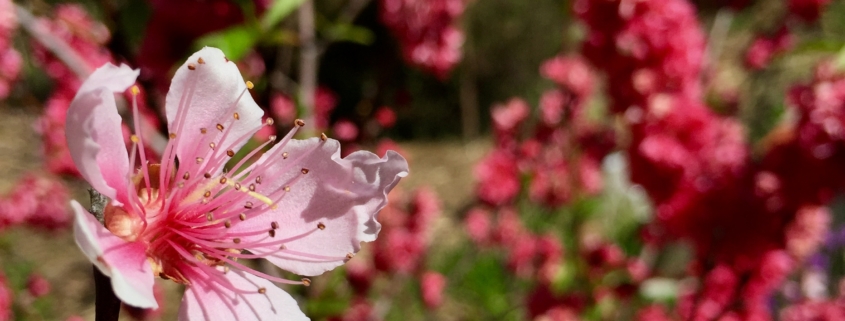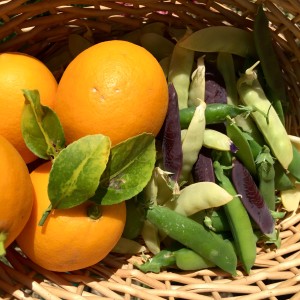Winter to Spring: Practicing Patience in the Midst of Life, Writing (& Gardening) Transitions
The first flowers of spring have come, calling all bees, all aphids, lady beetles, and grasshoppers, and waking all young, yellow and red striped potato bugs from the soil. Everything with legs is hungry, thirsty, busy flying or crawling about looking for water or food in the white heads of dandelions, along green leaves, or in the gusts of Santa Ana wind trails above the earth. It is the hum, the busy, the itch of spring stirring in all us.
I am no different than the aphid, hungry for green collard leaves, eager to feel the softness of pea flowers on my skin. Or, the grasshopper, hopping from one plant to another, hard to settle down, unable to be still and just watch the sun and sky grow colors all around. Sit still, I chide myself, settle down and record all the shifts from fuchsia to mauve to brown the peach blossoms have learned to paint.
I don’t know how I can move, be busy and unsettled, in the shift between winter and spring. How can I not be still, not pause amidst so much new life, growth? Somehow, I always manage to stumble here, and not pause or honor the shift.
There are seeds to sow. Beds to clean. Food to harvest. Plants to plant. A whole season to plan for and get ready to embrace, knees dirty, palms muddy, and muscles sore. What of patience? What of slowing down, when there is so much shifting, so many transitions to make.
As always, my garden life reflects my writing life. The garden is shifting from winter to spring, from cool to warm, from broccoli to tomatoes, and I, too, am shifting—from poetry to fiction, from student to graduate, from learning to practicing to producing.
Like the cabbage plants flowering in my garden, I am also shifting from one life cycle to another. Like her, my head is split and out sprouts yellow flowers. Unlike her, I struggle with transitioning. I cannot say I know the labor and pains cabbage feels to birth her flowers, but I look at how wide she allows herself to split, how tall she lets her flower stalks grow, how productively she sets and gives her seeds, and I know I am nothing like her. Not yet.
My transition from poetry to fiction writing has been laborious, gutturally painful, at times, and filled with silence. Where I once wrote for hours, I struggle to pen for minutes. Where there were once movie reels playing non-stop in my head, there is stillness and silence. I can no longer hear the stories I thought I owned in my heart.
After knowing myself as a fiction writer for many years, this year I have started to doubt and question my voice. I have examined the stories I’ve told, the images I’ve collected, the words I’ve put on paper and have begun to reconsider my voice. I am a poet. I tell true stories grounded in images, senses, and life as I’ve lived it.
I collect colors, not characters. I hoard the direction the wind blows, the angle sunlight falls, the shape of clouds, not plots and dramatic scenes. I observe and paint the poems I see in the world.
Whereas the cabbage plant cleaved herself open in the face of transition, to make way for her flower and seeds, I have sealed myself shut and shunned what I am beginning to know as true. I came into this writing program to leave with a finished novel, I have already written 292 pages of fiction, of course I am a novelist. Of course. Truthfully, though, my novel is 292 pages away from being finished, and I am not sure I am (or want to be) a novelist.
What I have failed to heed, to see, to cleave myself open to is the 48-page poetry manuscript I have finished, along with the truth, the earnest truth and discovery that I am a poet. I have failed to fully accept the shift. I’ve closed myself up to growth, and refused to let go of past seasons, ideas of myself.
With great guidance from my mentor, I have learned to be patient and kind with myself during this transition, and it is within this self-compassion and patience that I have found peace. Instead of mourning labels I’ve imposed on myself as a writer, and early goals I made, I’ve shifted my perspective to honor what I have become, what I have accomplished.
The world erupts in color when we cease drawing black frames around it, others, and ourselves.
We must learn to cleave open, like the cabbage plant, and grow tall, stately yellow flowers and seeds. We must not, ever, become too rigid to open, especially as writers. To shift, or change our perspectives, our understanding, our ideas. We must always choose to grow.
My Meyer lemon tree is heavy with fruit. Lemons that started budding a year ago are just now turning orange, sweet, and juice filled. This afternoon, as I harvested a few for dessert, I noticed new buds forming. I couldn’t help but think about how she is transitioning this spring, with last year’s fruits ripe and this year’s fruits beginning to bud. She honors both and allows herself, always, to fruit. I can do that, too, I whispered to her. I can honor the voice I’m leaving and the voice I’m embracing.
Before I sign off, I have a list to help you cleave open and embrace transitions. And, following that list, a recipe for Raspberry & Meyer Lemon Sweet Rolls.
Ten Ways to Lean into Transitions/Shifts:
- Be kind, gentle, and compassionate with yourself while you shift. It is all new; know that you are learning as fast and as earnestly as you can.
- Alter your perspective. Don’t be afraid to see things in new light, to change how you view your new world.
- Change your reaction. Instead of fear, dread, avoidance, practice acceptance, and embrace what is new. New does not mean bad.
- Embrace and honor the shift. Focus your attention on it, explore it, and savor it.
- Slow down. Don’t try and rush through the process; don’t be afraid of taking time to shift and transition. Be still.
- Trust the process. Have faith that you are going somewhere wonderful, and equally fruitful and exciting.
- Acknowledge past fruits. Recognize everything the old season of your life gave you—the tools, the insights, the ideas—honor them and bring them along, into your new journey.
- Cultivate excitement. Take on an attitude of pure elation, thrill, and adventure. Who knows in what exciting ways you’ll grow.
- Be imperfect. Perfectionism and people pleasing will strip all joy from your transition and growth. Know that you are exactly where you need to be.
- Learn and practice accountability. Whether it is by keeping track of goals, or teaming up with a trusted accountability partner, find a way to stay focused and true to your growth.
Raspberry & Meyer Lemon Sweet Rolls
(adapted from A Treasury of Top Secret Recipes)
These rolls are a welcomed change from traditional cinnamon rolls. Their fruity flavors are a refreshing surprise, and despite their big tastes, the combination isn’t overly sweet. The Meyer lemon and raspberry combination is light, bright, and a wonderful way to usher in spring. Feel free to substitute regular lemons for Meyers, but be warned, Meyer lemons are sweet, so your results may differ.
Sweet Rolls:
2 ½ tsp. active dry yeast
1 c warm almond milk (105-110 degrees)
½ c sugar
1/3 c melted butter, cooled
2 eggs
½ tsp. vanilla extract
¼ tsp. almond extract
1 tsp. salt
4 c all-purpose flour
Raspberry-Meyer Lemon Filling:
½ c raspberry jam
2 tsp. Meyer lemon juice
zest of lemon
Icing:
1 1/3 c powdered sugar
2-3 tbl. Meyer lemon juice
½ tsp. light corn syrup
Directions:
- To make the rolls: Dissolve yeast in warm milk in a large bowl; set aside to proof. In another bowl, mix the sugar, butter, eggs, salt, and extracts; add flour and mix until everything is well blended.
- Pour the flour mixture in with the yeast and knead until a large ball forms either by hand (dusted with flour), or in the bowl of a stand mixer. The dough will be silky, a bit sticky, and thick. Lightly oil a bowl and place dough into bowl, cover with plastic wrap, and let rise in a warm place until the dough has doubled in size (about an hour).
- While the dough is rising, make the filling. Pour the jam into a small bowl, add the lemon juice and mix until the jam is smooth and thinned.
- Preheat oven to 400 degrees.
- To form the rolls, lightly flour a work surface. Roll the dough out into a 20 x 15 rectangle. Sprinkle lemon zest over the dough and lightly press it into the dough. Spread the raspberry jam over the rectangle, leaving a 1-inch border around the edges. Working along the long side, tightly roll the dough.
- Cut the rolled dough into 1 ½ – 1 ¾ inch slices and place the rolls in an oiled pan. Let the rolls rise, covered in a warm place, until double in size (about half an hour).
- Bake the risen rolls for 10-15 minutes, until the tops lightly brown.
- While the rolls are cooling, combine icing ingredients and whisk well. Add more sugar or juice as needed to achieve desired consistency. Drizzle icing over slightly warm rolls.
Write, Create, Live, Eat Well!










